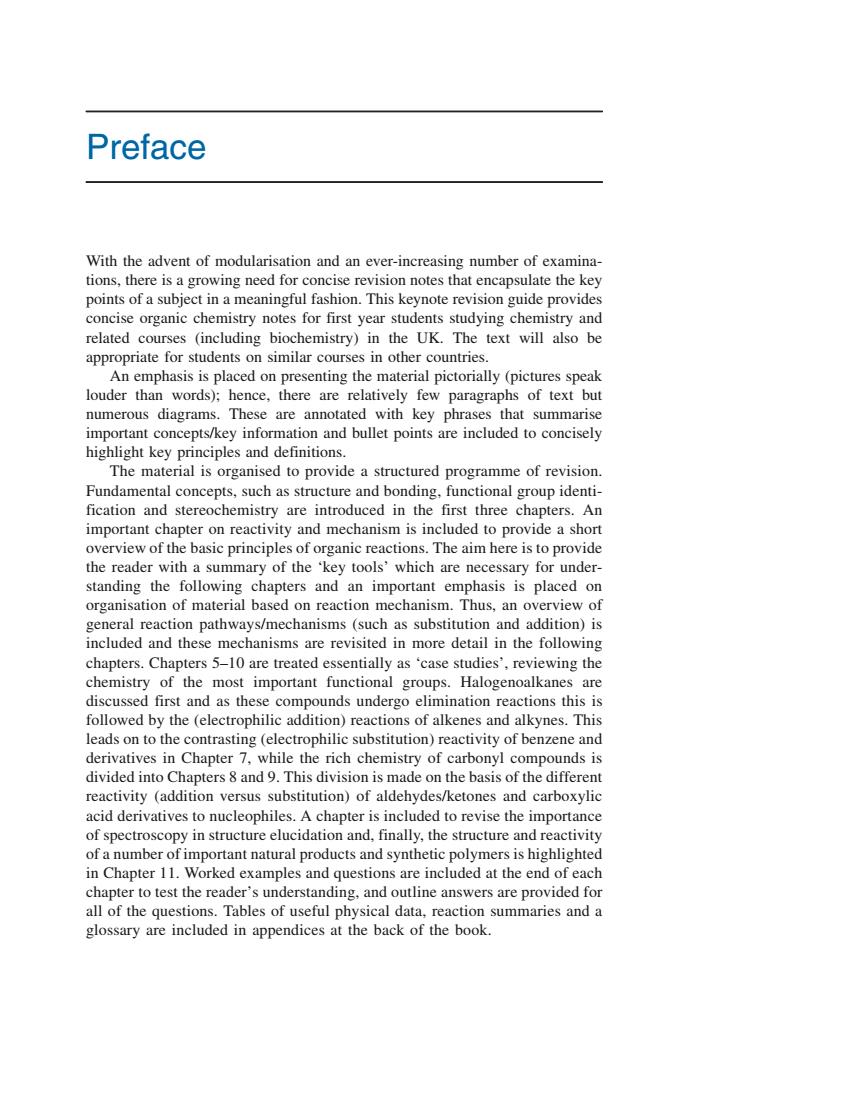正在加载图片...

Preface With the advent of modularisation and an eve reasing number of examina tions,ther ing ne ed fo otes that caps ulate the e ide for related emistry) in the UK.The text will also be appropria similar c oude ced ng t material pictorially (pictures eak word nce. latively few paragrap of text bu e are ann key phras /key inf ciples efinition ed to provide a struct red programme of revision Fu dament 1g, ona stry ar ntro important c of the e ity and m I to prov the reade ummary of the organi The ai ere Is pro which are nec following an em materia based on rea Inus,an o 2 rea an mechanisms are revisite in more de e follo chapters.Chapters 5-10 are treated essentially as 'case studies',reviewing the chemistry of the most important functional groups.Halogenoalkanes are discussed first and as these compounds undergo elimination reactions this is followed by the (electrophilic addition)reactions of alkenes and alkynes.This leads on to the contrasting (electrophilic substitution)reactivity of benzene and derivatives in Chapter 7.while the rich chemistry of carbonyl compounds is divided into Chapters 8 and 9.This division is made on the basis of the different reactivity (addition versus substitution)of aldehydes/ketones and carboxylic acid derivatives to nucleophiles.A chapter is included to revise the importance of spectroscopy in structure elucidation and,finally,the structure and reactivity of a number of important natural products and synthetic polymers is highlighted in Chapter 11.Worked examples and questions are included at the end of each chapter to test the reader's understanding,and outline answers are provided for all of the questions.Tables of useful physical data,reaction summaries and a glossary are included in appendices at the back of the book. Preface With the advent of modularisation and an ever-increasing number of examinations, there is a growing need for concise revision notes that encapsulate the key points of a subject in a meaningful fashion. This keynote revision guide provides concise organic chemistry notes for first year students studying chemistry and related courses (including biochemistry) in the UK. The text will also be appropriate for students on similar courses in other countries. An emphasis is placed on presenting the material pictorially (pictures speak louder than words); hence, there are relatively few paragraphs of text but numerous diagrams. These are annotated with key phrases that summarise important concepts/key information and bullet points are included to concisely highlight key principles and definitions. The material is organised to provide a structured programme of revision. Fundamental concepts, such as structure and bonding, functional group identification and stereochemistry are introduced in the first three chapters. An important chapter on reactivity and mechanism is included to provide a short overview of the basic principles of organic reactions. The aim here is to provide the reader with a summary of the ‘key tools’ which are necessary for understanding the following chapters and an important emphasis is placed on organisation of material based on reaction mechanism. Thus, an overview of general reaction pathways/mechanisms (such as substitution and addition) is included and these mechanisms are revisited in more detail in the following chapters. Chapters 5–10 are treated essentially as ‘case studies’, reviewing the chemistry of the most important functional groups. Halogenoalkanes are discussed first and as these compounds undergo elimination reactions this is followed by the (electrophilic addition) reactions of alkenes and alkynes. This leads on to the contrasting (electrophilic substitution) reactivity of benzene and derivatives in Chapter 7, while the rich chemistry of carbonyl compounds is divided into Chapters 8 and 9. This division is made on the basis of the different reactivity (addition versus substitution) of aldehydes/ketones and carboxylic acid derivatives to nucleophiles. A chapter is included to revise the importance of spectroscopy in structure elucidation and, finally, the structure and reactivity of a number of important natural products and synthetic polymers is highlighted in Chapter 11. Worked examples and questions are included at the end of each chapter to test the reader’s understanding, and outline answers are provided for all of the questions. Tables of useful physical data, reaction summaries and a glossary are included in appendices at the back of the book